Unlocking ESP Learners’ Leadership and Higher-Order Thinking Skills through Whatsapp Community of Practice
DOI:
https://doi.org/10.54855/ijte.24413Keywords:
community of practice, English for Specific Purposes, Gender, Higher-order thinking skills, Leadership skills, WhatsAppAbstract
This study investigates the relationship between the WhatsApp group, an instant messenger application as a community of practice platform (knowledge management, regular interactions, ease of using technology, and sense of belonging) and English for Specific Purposes (ESP) learners’ leadership and higher-order thinking (HOT) skills. The current study also examines how participation in the community of practice through the WhatsApp group can enhance leadership and HOT skills for male and female learners. 197 ESP learners participated in the five-point Likert scale questionnaire. The SPSS-AMOS analysis showed that knowledge management, regular interaction, and a sense of belonging significantly enhance learners’ leadership and HOT skills. The results also showed that male learners increased their leadership skills while female learners excelled in the HOT skills by the WhatsApp community of practice. This study has significant educational implications, particularly in emphasizing essential measures when developing an ESP curriculum to prepare learners for their future careers
References
Alouch, M., Ganapathy, M., & Lin, D.B.A. (2021). Using WhatsApp to promote ESL students’ writing.The Asian Journal of English Language and Pedagogy, 9(2), 54-65. DOI:https://doi.org/10.37134/ajelp.vol9.2.5.2021
Al-ghamdi, H. A. K., & Al-ghamdi, A. A. K. (2015). The role of virtual communities of practice in knowledge management using web 2.0. Procedia Computer Science, 65, 406-411. https://doi.org/10.1016/j.procs.2015.09.102
Andrienko, A. (2017). The role of virtual educational environment in English for specific learning purposes. Advances in Computer Science Research, 72, 209– 215. https://doi.org/10.2991/itsmssm-17.2017.45
Bates, T. (2014). The role of communities of practice in a digital age. Online Learning and Distance Education Resources. https://www.tonybates.ca/2014/10/01/the-role-of-communities-of-practice-in-a-digital-age/
Bhattacherjee, A. (2012). Social science research: Principles, methods, and practices. http://scholarcommons.usf.edu/oa_textbooks/3
Bourhis, A., Dube, L., Jacob, R. (2005). The success of virtual communities of practice: The leadership factor. The Electronic Journal of Knowledge Management, 3(1), 23-34.
Channing, J. (2020). How can leadership be taught? Implications for leadership educators. International Council of Professors of Educational Leadership, 134-148.
Chrisentary, J., & Barett, D. (2015). An exploration of leadership in virtual communities of practice. Management, 20(77), 25-33.
Ciardiello, A. V. (2000). Student questioning and multidimensional literacy in the 21st century. The Educational Forum, 64(3), 215-222.
Cronjé, J. C., & Izak, V.Z. (2022). WhatsApp as a tool for building a learning community. The Electronic Journal of e-Learning, 20(3), 296-312. https://doi.org/10.34190/ejel.20.3.2286
Della Líbera, B., & Jurberg, C. (2020). Communities of practice on WhatsApp: A tool for promoting citizenship among students with visual impairments. British Journal of Visual Impairment, 38(1), 58–78. https://doi.org/10.1177/0264619619874836
Dogoriti, E., & Pange. J. (2014). Instruction design for a “social” classroom: Edmodo and Twitter the foreign language classroom. Proceedings of the International Conference on Information Communication Technologies in Education, 154– 165.
Dominic, T. & Fulgence, K. (2019). Gender differences in enhancing students’ employability skills. Operations Research Society of Eastern Africa (ORSEA), 8, 57-71.
Downes, S. (2010). New technology supporting informal learning. Journal of Emerging Technologies in Web Intelligence 2(1), 27-33. https://doi.org/10.4304/jetwi.2.1.27-33
Doyle, A. (2023, April 5). Critical thinking definition, skills, and examples. ThoughtCo.thoughtco.com/critical-thinking-definition-with-examples-2063745.
Dudley-Evans, T., & St. John, M. J. (1998). Developments in English for specific purposes: A multi-disciplinary approach. Cambridge University Press.
Ekici, D. I. (2017). The use of Edmodo in creating an online learning community of practice for learning to teach science. Malaysian Online Journal of Educational Sciences, 5(2), 91–106.
Field, A. (2009). Discovering statistics using SPSS (3rd Ed.). Sage Publications Ltd.
Fisher, A., Exley, K., & Ciobanu, D. (2014). Using technology to support learning and teaching. Routledge.
Gatehouse, K. (2001) Key issues in English for specific purposes (ESP) curriculum development. The Internet TESL Journal, 7(10), 1–10.
Ghamrawi, N. (2022) Teachers’ virtual communities of practice: A strong response in times of crisis or just another Fad?. Education and Information Technologies, 27, 5889–5915 (2022). https://doi.org/10.1007/s10639-021-10857-w
Goncalves, L. (2021). Communities of practice, a tool for fantastic product-first companies. ADAPT Methodology. https://adaptmethodology.com/communities-of-practice/
Hair, J. F., Black, W. C., Babin, B. J., Anderson, R. E., & Tatham, R. L. (2006). Multivariate data analysis (6th ed.). Pearson University Press.
Hatane, S. (2009). The impact of e-learning on employability skills development in small organization (A Study Case of a Small Organization in Blitar, East Java, Indonesia). The Sixth International Conference on eLearning for Knowledge-Based Society,1-6.
Ho, T. M. L., & To, M. T. (2022). Delegating critical thinking skills in learners through effective questioning technique in the class. International Journal of TESOL & Education, 2(3), 13-31. DOI: https://doi.org/10.54855/ijte.22232
Jacob, B.A. (2002) Where the boys aren’t: non-cognitive skills, returns to school and the gender gap in higher education. Economics of Education Review, 21(6), 589–598.
Javid, C. Z. (2015) English for specific purposes: Role of learners, teachers and teaching methodologies. European Scientific Journal, 11(20), 17–34. http://eujournal.org/index.php/esj/article/view/5950/5736
Jing, S. (2017). Compare and contrast of 46constructivism and community of practice. 3rd International Conference on Social Science, Management and Economics, 114–126.
Khan, T.J. (2016). Motivation for reading English as a Second Language (ESL) through the use of WhatsApp among Graduate Students of Government College Township, Lahore (Pakistan). International Journal of Pure and Applied Researches, 1(2), 220-229.
Korlat, S., Kollmayer, M., Holzer, J., Lüftenegger, M., Pelikan, E.R., Schober, B & Spiel, C. (2021). Gender differences in digital learning during COVID-19: Competence beliefs, intrinsic value, learning engagement, and perceived teacher support. Frontiers Psychology. 12, 1-12. https://doi.org/10.3389/fpsyg.2021.637776
Krejcie, R. V., & Morgan, D. W. (1970). Determining sample size for research activities. Educational and Psychological Education, 30(3), 607–610. https://doi.org/10.1177/001316447003000308
Li, L.C., Grimshaw, J.M. & Nielsen, C. (2009). Evolution of Wenger's concept of community of practice. Implementation Science, 4(11), 1-8. https://doi.org/10.1186/1748-5908-4-11
Mahyoob, M. (2020). Challenges of e-learning during the COVID-19 pandemic experienced by EFL learners. Arab World English Journal, 11(4), 351-362. https://dx.doi.org/10.24093/awej/vol11no4.23
Mawanga, F. F. (2018). Gender characteristics of secondary school teachers using computers in and around Kampala City of Uganda. Operations Research Society of Eastern Africa (ORSEA), 8(2), 31–40.
Mheidly, N., Graña, G.G., & Tayie, S.S. (2021). Learning through Whatsapp during the Covid-19 pandemic: A case study. Asia-Pacific Journal of Information Technology and Multimedia, 10(2), 136-145.
Neuman, W. L. (2014). Social research methods: Qualitative and quantitative approaches (7th ed.). Pearson New International Edition.
Nsabayezu, E., Iyamuremye, A., de Dieu Kwitonda, J., & Mbonyiryivuze, A. (2020). Teachers’ perceptions towards the utilization of WhatsApp in supporting teaching and learning of chemistry during COVID-19 pandemic in Rwandan secondary schools. African Journal of Educational Studies in Mathematics and Sciences, 16(2), 83-96.
Paltridge, B., & Starfield, S. (2013). Handbook of English for specific purposes. Wiley-Blackwell.
Patel, A. (2023). How Technology Can Be Used to Empower Leadership. https://aboutleaders.com/technology-empower-leadership/
Penfold, P. (2010). Virtual communities of practice: Collaborative learning and knowledge management. Third International Conference on Knowledge Discovery and Data Mining. https://doi.org/10.1109/WKDD.2010.70
Pető, R., Reizer, B. (2021). Gender differences in the skill content of jobs. Journal of Population Economics, 34, 825–864. https://doi.org/10.1007/s00148-021-00825-6
Pham, N. T., & Nghiem, H. V. (2022). Online teaching satisfaction amid the Covid-19 pandemic: Evidence from a Vietnamese higher education context. International Journal of TESOL & Education, 2(1), 310-326. DOI: https://doi.org/10.54855/ijte.222119
Robinson, P. (1991). ESP today: A practitioner’s guide. Prentice Hall.
Sibbald, S.L., Burnet, M.L., Callery, B. (2022). Building a virtual community of practice: experience from the Canadian foundation for healthcare improvement’s policy circle. Health Research Policy and System 20. https://doi.org/10.1186/s12961-022-00897-0
Soto, M. A., & Waigandt, D. (2017). Authenticity in ESP course: Building communities of practice. In D. L. Benegas, M. Lopez-Barrios, & D. Waigandt (Eds.), Authenticity in ELT: Selected papers from the 42nd FAAPI Conference 109–118.
Wenger, E., McDermott, R. A., & Snyder, W. (2002). Cultivating communities of practice: A guide to managing knowledge. Harvard Business Press.
Downloads
Published
Issue
Section
License
Copyright (c) 2024 Jayanthi Muniandy, Subathira Devi Ramaya

This work is licensed under a Creative Commons Attribution 4.0 International License.
The copyright of all articles published in the International Journal of TESOL & Education (ijte) remains with the Authors, i.e. Authors retain full ownership of their article. Permitted third-party reuse of the open access articles is defined by the applicable Creative Commons (CC) end-user license which is accepted by the Authors upon submission of their paper. All articles in the ijte are published under the CC BY-NC 4.0 license, meaning that end users can freely share an article (i.e. copy and redistribute the material in any medium or format) and adapt it (i.e. remix, transform and build upon the material) on the condition that proper attribution is given (i.e. appropriate credit, a link to the applicable license and an indication if any changes were made; all in such a way that does not suggest that the licensor endorses the user or the use) and the material is only used for non-commercial purposes.
Authors retain copyright and grant the journal the right of first publication with the work simultaneously licensed under a Creative Commons Attribution 4.0 International License that allows others to share the work with an acknowledgment of the work's authorship and initial publication in this journal.
Authors are able to enter into separate, additional contractual arrangements for the non-exclusive distribution of the journal's published version of the work (e.g., post it to an institutional repository, in a journal or publish it in a book), with an acknowledgment of its initial publication in this journal.











